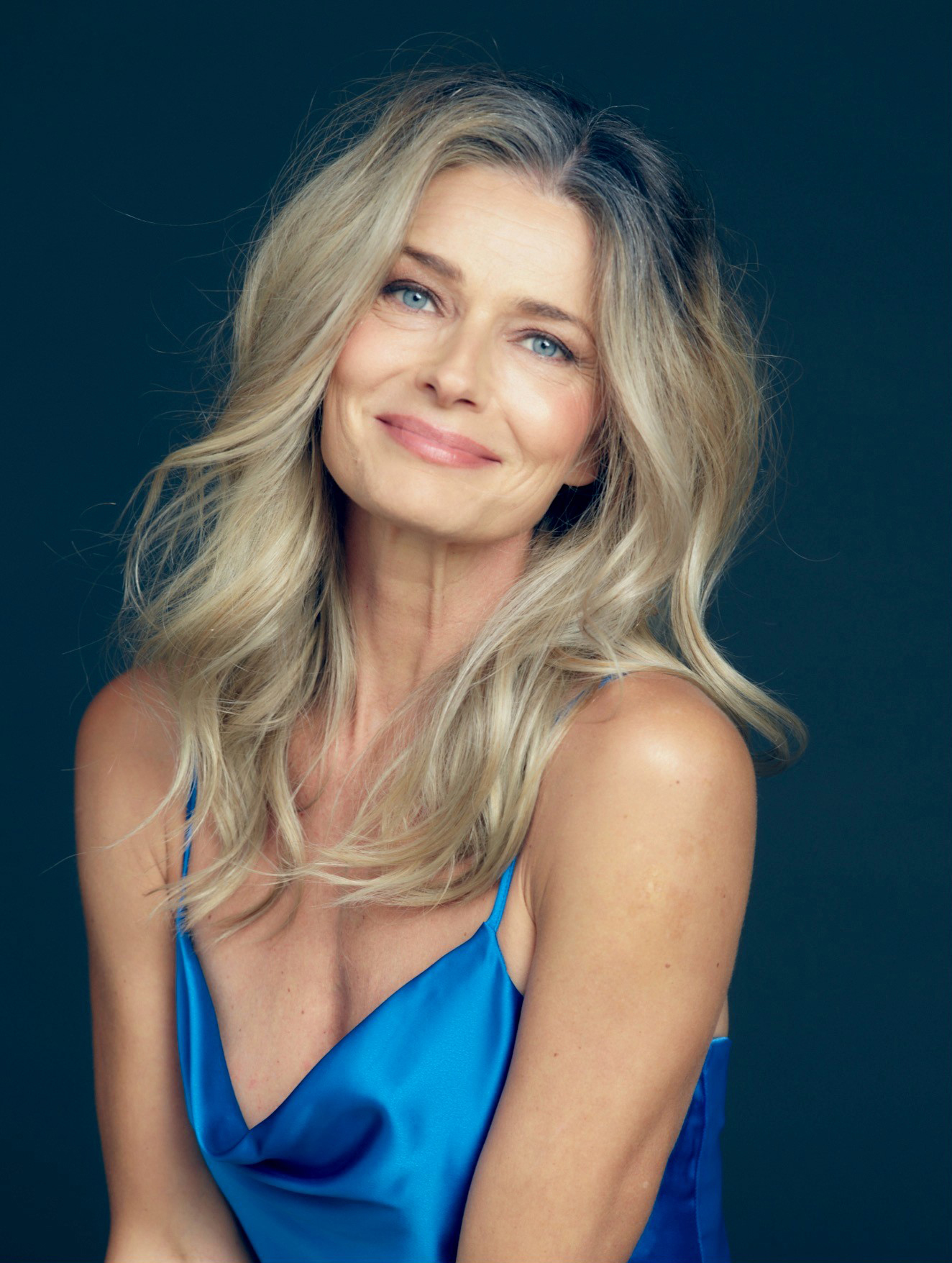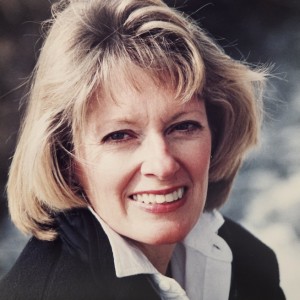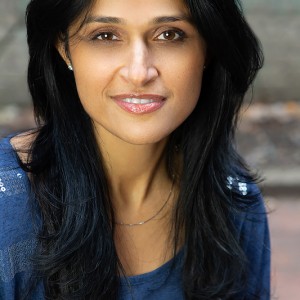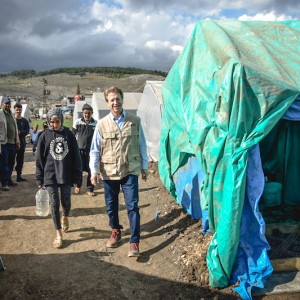All she did was post a photo of herself in a bikini on Instagram and all hell broke loose. Paulina Porizkova, the supermodel who had spent a lifetime posing for the camera and was called the most beautiful woman in the world, had the nerve to show her body, the body of a woman over 50, on social media and the trolls went ballistic. Porizkova, the author of No Filter: The Good, the Bad, and the Beautiful, now confident in herself and her skin, found her voice and fought back. In a society where “isms” fill headlines, she took on the one no one wanted to touch. The final frontier of discrimination–ageism–specifically ageism against women. She didn't just call it out, she invited it onto the front porch for a conversation and a cocktail. And she did it with the whole world watching.
Born into Cold War Czechoslovakia, Porizkova was abandoned at the age of 3 to the care of her grandmother when her anti-soviet dissident parents fled to Sweden to escape the Warsaw Pact invasion. When she was 7 her mother, pregnant at the time, returned to rescue her daughter and was placed under house arrest. The media storm that ensued turned Porizkova into a political pawn with photos of her face splashed all over the papers. She and her mother were allowed to leave. Upon their arrival in Sweden, Porizkova’s father promptly abandoned the family, leaving his wife for another woman. At school, she was physically and mentally bullied by her Swedish classmates. At home, she struggled to care for her younger brother while her mother worked. With little money, Porizkova resorted to shoplifting at times to provide food for them to eat. When she was 13, a chance discovery by an agent landed her a modeling contract and by 15 she was on a photoshoot in Paris where she was sexually harassed by a photographer as stylists stood by and laughed it off. In 1988 at the height of her career, she won a $6 million contract as the face of Esteé Lauder–the highest in the industry at that time. She was on the cover of Sports Illustrated twice, was featured on 21 Vogue covers and thousands of other publications, She has been the face of numerous top-brand advertising campaigns, acted in movies, television shows and music videos, was on America’s Next Top Model as a judge and Dancing with the Stars as a participant. She took writing classes and prior to her recent book, wrote and published Ralphie the Roach, a children’s book and A Model Summer, her first novel.
She fell in love at the age of 19 with Ric Ocasek, lead singer for The Cars and after they were married, she dialed back on the modeling assignments and focused on her family, creating a strong blended clan of her two children and Ocasek’s children from another marriage. She deferred to her much older husband who dictated the confines of her career, finances and life.
On paper it looked like a charmed life–a supermodel married to a rockstar. But as she approached 50, her marriage slowly crumbled. Her husband seemed to lose interest in her, the modeling jobs dried up and she felt invisible. The couple decided to separate but live together in their marital home and wait to sell it until after the divorce. Porizkova thought everything was amicable. They planned to get separate apartments close to each other and to always support each other. They were family. When Ocasek was diagnosed with cancer and had surgery, Porizkova stood by his side.
Then in the fall of 2020 came the perfect storm. The sudden death of her estranged husband a year earlier in the home they still shared was followed by the deepest betrayal. Ocasek had written her out of his will two weeks prior to his death. Despite being a breadwinner for the family for many years, Porizkova had no access to money, her home was heavily mortgaged and accounts were tied up in litigation. To add insult to injury, the man she had been dating dumped her. She was alone. During Covid. Broken hearted, betrayed and most painfully abandoned. She would need to reinvent her life. She had done it many times before. In order to do that though she needed someone to show her the way. Drowning in grief and despair, she shouted into the void of the internet and waited for help.
Enter her followers, 1.1 million of them on Instagram to date, who lifted her up and provided the platform for her to share her voice. Porizkova posted soulful musings with raw emotion alongside the barefaced unfiltered selfies of a grieving woman trying to pull herself up by her bootstraps. “When I was at my worst, in that period between my husband’s death and me writing the book, and Covid, everything bad just happened all at once. People would say to me, you’re experiencing this for a reason, you’re being nudged by the universe to go to the next step and it might be painful in the meantime, but you will find out why this was necessary. And I just felt f*** off. If you’re right then great, but it’s so not helpful right now when I am drowning to tell me that I’m drowning for a good reason. It is absolutely not helpful”, she says. Connection was her way out of the darkness and during the pandemic the form of connection available to her was Instagram. “We really need connections as humans and no, it doesn’t have to be romantic connections. Family can be friends. I knew that if I could turn my love outward, it would sort of mirror back to me. So I think turning your love outwards, whether it’s the connection or doing something good for somebody else, helping people in need, I know it sounds trite but being generous and being kind to others makes you feel better about yourself. My biggest lesson–love turned outwards” she says.
Porizkova was celebrated for her honesty, vulnerability and courage, the latter being something she says helped her to keep moving despite the crippling anxiety and panic attacks she has suffered from for years. She notes that “If you were to ask me which one of my attributes I’m the most proud of I would say my courage. That is the one thing that I’m certain of. I know I’m courageous because I’m fearful as hell. I have so many fears. I am a ball of fear from morning to night. And I function despite it.” Maria Shriver, so impressed with Porizkova ’s candid posts, asked her to write a book in the same fashion as her instagram.
But then came the trolls and the inevitable questions about whether a woman of a certain age has a right to live her life as she deems fit. Everyone had an opinion it seems. Some of them were vile. Of her bikini photo, one commenter wrote, ‘You must be in so much pain to keep posting bikini pictures at your age. I’ve always thought that getting old and ugly is hardest on the pretty people. The fall from grace is so much father when you were beautiful. I pray you can come to terms with your mortality. We all get old and ugly...you just had to fall from a greater height than the rest of us.’
Porizkova’s response was a study in eloquence and grace. “A woman of 57 is “too old” to pose in a bikini-no matter what she looks like. Because “old” is “ugly.” I get comments like these every time I post a photo of my body. This is the ageist shaming that sets my teeth on edge. Older men are distinguished, older women are ugly. People who believe prettiness equals beauty do not understand beauty. Pretty is easy on the eyes, partly because it’s a little bland, inoffensive, It’s easy to take in and easy to forget. Not so beauty. Beauty can be sharp. It can wound you and leave a scar. To perceive beauty you have to be able to SEE. This is why I believe we get more beautiful with age. We have earned our beauty, we understand what it is, and we can see it so much better. There is no such thing as old and ugly. Only short-sighted and ignorant,” she wrote.
She followed up with another stunningly gorgeous bikini post, this time with a touch of cheeky shade. She wrote, “A thoughtful reader comment on IG needs an equally thoughtful response. Thank you for feeling my pain. As you can see I’m suffering indeed.”
Then a fabulous thing happened. Outraged by this attack, women started sharing stories of their “suffering” on Instagram, posting photos of themselves in bikinis in support of Porizkova with a special hashtag. #Old&Ugly quickly went viral. A supporter wrote: “I’m 50. The super cool thing about being 50, I’ve discovered, is I truly don’t give a @#$% what anyone thinks, and i’m glad you don’t, either. You’re just as gorgeous as ever. May we all keep posting our “suffering.” Porizkova responded, “You suffer beautifully”.
Recently another slew of hate and outrageous comments were directed at her: “She looks 75 years old, no less . . . my 83-year-old grandma looked like this.”
“ I would love to see her hair colored. It’s pretty brown. She would look 30 years younger….”
“Jeeeeeeezzzzz..she’s looking 70!”
The disheartening thing is that the majority of these comments were from women. “Nobody trashes women as effectively as women,” Porizkova says. “And I think it’s all shame-based. You don’t feel good about yourself, so you take your shame out on somebody else. It’s infantile. It’s not very advanced. But this is what people do and I think it’s this shame that you might not be enough.”
Porizkova notes that social media has led to more comparison and competition that provides the fodder for the trolls. She says, “One thing I’ve spent a lot of time contemplating lately is the comparison market. We’re programmed to compare because that’s how you know your position in the world—where you belong. But when we were growing up, the comparisons were to your friends and the people in school. So, your field of comparison was fairly narrow. Now you go on social media and you are bombarded with images of not only your friends that look way better than you think you will ever look, but of everybody. It’s just constant visuals that you can’t help but draw comparisons between. The representation of people tweaking themselves so that they can showcase themselves as they would like to be seen as opposed to who they are. It’s mind blowing just the sheer amount of it.”
In recognizing the platform that provided her with support in her darkest hour was also the source of the cruel jabs, she says that part of the issue was the nature of the platform itself. “How do you connect as a human being to other human beings? How do you trade love? It’s not based on perfection. It’s based on vulnerability, which nobody apparently has anymore because you can filter that and so I think it’s just because we are still in the beginning stages of this whole Internet revolution thing. The virtual world–we don’t quite know how to navigate it. Our brains are not keeping up with technology. We’re floundering and people are yelling insults at each other, and they’re all dividing up into tiny little cliques. I decided that I can only handle my little corner. So I’m going to be the person I want to be and the person that I would like to see. If I don’t see those people, then I’ll be one. So it’s a good thing to start - if you want some kindness, be kind,” she says.
Porizkova is no stranger to public projection. When she was first modeling she desperately tried to be taken seriously. She never wanted to be a model and would have much preferred to be a writer or an artist. She was and is whip smart but as Porizkova notes she was considered “smart for a model which is a low bar.” Any chance she had to showcase her intelligence or opinion and was shut down, not that she didn’t try. She fought back, giving magazine and television interviews that showed her self-deprecating sense of humor and brilliant retorts to insulting questions. In 1985 she was interviewed on the iconic Late Night with David Letterman and legendarily put him in his place. Porizkova knew Letterman would make jokes at her expense. She was ready. “Don’t you think models are superficial, vain, self-absorbed and shallow?” he asked. “Absolutely!” she replied. “Oh really? But you don’t think you’re that way?” he pressed. “Of course not, because I don’t think of myself as a model,” she said. Astonished, Letterman asked, “Oh, so what are you?” With a side smile and arched eyebrow Porizkova shot back, “A human being Dave.” She was 21. When young, she had to fight to prove that intelligence and beauty can coexist. Now she is fighting to prove that age does not render women irrelevant.
The recipient of the 2023 Women Who Roar SRQ Trailblazer Award presented to women who are passionate about living their dreams at any age, Porizkova has become a light in the darkness and a guide inviting others along the journey of living a fabulous life as a 50 something woman. She is amazed at the audience she has and is deeply grateful for their support. When reminded of how large her Instagram following is she responds with amazement, “When you say I have a million followers, how did that happen? I’m so grateful that I do. it boggles my mind. When I go to these events for my book, and my ladies are there to greet me there’s unity and it’s unbelievable. And this came about because I was reaching out to them. This is a community built on connections with kindness.”
She says that she never intended to become the face of positive aging, “That was an enormous amount of luck because it was not a conscious move on my part, I had no idea what I was doing. I was just trying to connect to other lonely people out in the universe. I also didn’t know that my own aging face was going to be seen as off putting as it did to certain people. I mean, initially, I would get shocked by the ‘old hag retire yourself’ comments. I thought that I was doing pretty okay for my age. I’ve had an entire life of carrying other people’s assumptions about who I was so that is the one thing I wanted to dismantle. I’m just going to be myself and being myself means I don’t want to erase my age. I’m not the airbrush filtered version that looks 30 years younger and I have the sense that this is better. I know it’s not celebrated, but it is actually better. I feel like I like myself. I have more confidence. So, why not embrace this?” she says.
She notes the topic of ageism is complicated in this modern age. “I feel like we are starting to talk about ageism now but everybody’s really confused on the topic because you don’t have to look your age. Then it’s sort of like what is ageism? Is it looking at the people who are aging naturally as sort of giving up and therefore ageism is okay when directed at them? And the ones who are fighting it and taking steps not to look old are aging gracefully therefore they will be less discriminated against? I think we’re sort of in the infancy of taking on ageism because for most of our existence, for women, ageism was just the fact that after you went through menopause you were dead as far as anybody was concerned. It’s not the same for men and I think the world has at least come so far as to where women do have a voice and we can speak up and say we don’t think that’s cool. We don’t think that’s fair. So that’s a positive step,“ she says.
But the impact of ageism against women is more than just trolls on the internet and pressure to have cosmetic surgery. There are huge financial and market implications as well. The following statistics are jaw dropping. The buying power of women older than 50 is $15 trillion which represents 27% of all consumer spending according to Business Insider. However just 5- percent to 10-percent of marketing budgets are directed toward 50-plus consumers, reports the Harvard Business Review. As a result, 91-percent of this demographic feels ignored and misunderstood, according to research by GirlPower Marketing. “Part of that is our fault,” Porizkova says. “Because when we buy, we don’t want to buy from our peers. We want to buy from women that we wish we looked like. And it’s not our age, it’s younger. We don’t want to buy an anti-aging cream from a woman who has wrinkles because then it didn’t work. We buy it from a 30 year old on which it apparently worked miracles. This is the self-defeating part of it and it’s understandable. I know, because I buy into the same system. It’s kind of a self-perpetuating problem that we are told that we’re not valuable when we are a certain age and so we all want to look a younger age to still remain valuable. So we all buy things that are advertised by young women. Then we perpetuate the idea that only younger women are valuable because they’re the only ones that sell. Of course it all always comes down to money. What sells is what’s going to be pushed on me. And then we push more women that look ageless or that look young and here we are just running as fast as we can on this treadmill while other people are walking in place.”
Women are also finally speaking out about ageism in the workplace. According to the latest "Mirror/Mirror" survey from AARP, nearly two out of three women age 50 and older say they are regularly discriminated against and those experiences appear to be taking a toll on their mental health. In an interview with Fortune, Heather Tinsely-Fox, a senior advisory of employee engagement at the AARP says, "Women face a much higher bar with regard to ageism; they experience it earlier and more frequently than men. Therefore, women may feel they need to take action to look younger, leading many to accrue a hefty cost."
When asked how women can combat ageism at work Porizkova notes, “There’s a huge expenditure of energy doing that. You just maintain the look part and then you also have to do the job better than everybody else in order to even stay in it. I sure as hell don’t have the answers. I do have a lot of questions. We’ve only started shedding light on this issue. This is just starting to be talked about and still at a fairly low level. I mean we did the whole conversation of what is beauty? It can be different colors. It can be different genders. It can be different sizes. When it comes to age, we still have to look like we’re below forty. And I think it’s an enormous amount of pressure on women. Fortunately, what comes with age is that you are better at dealing with pressure. But it’s ridiculous to have to erase your age so that you will be counted at the important tableand not relegated to the peanut gallery.”
On predicting the future, Porizkova is still on the fence. She says, “It’s really hard for me to tell which way it’s going to swing. For example, right now there’s a Vogue cover with the four supermodels on it. It’s lovely. I mean they’re extraordinarily beautiful women. But when you look at it, do you think they’re women in their mid-50s? You can be in your mid 50s if you look in your mid 30s and then you’re valuable. We keep getting that same message over and over. We’ll value you at 50 or 60 provided you look a whole lot younger. Then we’ll celebrate you, then we’ll say you’ve aged gracefully, which actually means you didn’t age at all, and you’ve taken great steps to look that way, which means it took a lot of money, and a lot of your time that you could have spent in other ways. For example, on the job.”
The next subject Porizkova wants to tackle is one she thinks is sorely needed by her demographic. “I’m thinking about writing a book about middle-aged dating and sex because I had three years as a single woman at the worst age possible to be single, so I feel like I have stories to tell. Sexuality and the older woman is such a taboo topic. Again, because we are a certain age we are not only supposed to disappear from the collective, from the workforce, but from sex also? No. More and more women are not willing to put up with that. I find it a really interesting topic that I would love to talk about with women. I remember when I was dating not that long ago, I just wished that there was a book that
spoke to me about this,” she says.
Happily she is now off the market and blissfully in love. She says “I had this amazing sense of faith that I was waiting for him to walk into my life. I didn’t know where he was. I didn’t know how long it was going to take, but I woke up on January 1st with this absolute certainty that I was waiting, the door was open and he would walk through it.” And he did. Porizkova describes her boyfriend Jeff as the most optimistic man who sees the world as magical. She says, “I got pretty much everything that I ever looked for. Again, with the perspective of distance and time, at 58 I look back at the life that I’ve had and I think, no question about it, this is the happiest I’ve ever been. I am perfectly fulfilled and I wake up every day and have this moment where I just say I’m embracing everything that I have because I’m so incredibly fortunate.”
On the darkness that threatened to consume her, Porizkova notes, “We’re all candles by nature of being alive. We are a flickering flame. It’s about recognizing and understanding that you are your own light. If you pay attention to the fact that the flickering flame that you keep looking for outside actually lives inside you, you’ll find it. Sometimes it just gets really, really dark and you need the reflections of light. You need fireflies. You need to know that there is the existence of light. Sometimes your light goes out. I feel like mine was close to not existing and this is where I needed to understand the possibility that light could be ignited again, maybe by another light.”
Now that she has found her way “blindly out of the mess” as she puts it, Porizkova says “I want to continue to do what I do now, which is meet women who give me strength and whom I can give strength to.” She is acting as a beacon for others all the while reminding us that she is just a fellow traveler on this journey. She says, “I’m carrying a lantern saying I’m going this way. Do you want to go this way? You’re welcome to come with me as long as everybody that’s going with me, also knows that I don’t know where I’m going. We’re going to discover this together. I don’t want to fall off the cliff, and I don’t know that I’m not heading for it, but I do feel like if there’s enough women walking in a circle with me we can navigate better. I can’t navigate all by myself.”










